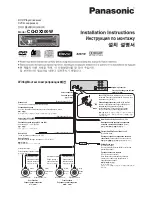
14
Preparations
Setting up the system
Connecting the terminals
1
Strip coating.
2
Push the lever.
3
Insert the cord.
4
Return the lever.
1
Strip coating.
2
Loosen.
3
Insert.
4
Secure.
• Never short circuit the + and – speaker cords.
• If the left and right speakers are connected inversely or the speaker
cords are connected with reversed polarity, the sound will be unnatu-
ral with ambiguous acoustic imaging. Be sure to connect the speak-
ers correctly.
1
Secure.
2
Insert.
Connection of banana plugs
• Sound will not be heard if the speaker terminal is not fully secured.
Speaker impedance
After confirming the speaker impedance indications printed on the rear
panel of the receiver, connect speakers with matching impedance
ratings. Using speakers with a rated impedance other than that indi-
cated on the rear panel of the receiver could result in malfunctions or
damage to the speakers or receiver.
Speaker placement
Subwoofer
Front speakers
: Place to the front left and right of the listening position.
Front speakers are required for all surround modes.
Center speaker
: Place front and center. This speaker stabilizes the
sound image and helps recreate sound motion. Be sure to connect a
center speaker when using the Dolby 3 Stereo mode.
Surround speakers
: Place to the direct left and right, or slightly
behind, the listening position at even heights, approximately 1 meter
above the ears of the listeners. These speakers recreate sound motion
and atmosphere. Required for surround playback.
Subwoofer
: Reproduces powerful deep bass sounds.
Front
speaker
Center speaker
Listening
position
Surround
speaker
• Although the ideal surround system consists of all the speakers listed
above, if you don't have a center speaker or a subwoofer, you can
divide those signals between the available speakers in the speaker
settings steps to obtain the best possible surround reproduction from
the speakers you have available.
™
*510/07-19/EN
3/15/01, 11:40 AM
14















































